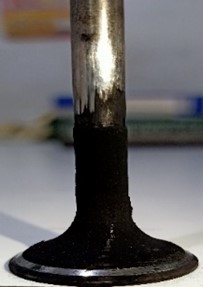EFFECTIVE REMOVAL OF EXHAUST VALVE DEPOSITS USING HIGHER ALCOHOL WITH GUTTER OIL IN SINGLE CYLINDER DIESEL ENGINE
DOI:
https://doi.org/10.71146/kjmr179Keywords:
Diesel Engine, Deposit formation,, N-pentanol , Gutter oil, Exhaust ValveAbstract
This study examined a CIDI engine's exhaust valve. while excessive silt builds up on the exhaust system walls, especially while driving in an urban area, or when there are leaks in the vacuum or exhaust pipes, the valve has a tendency to become stuck. To determine the amount of deposition buildup on the exhaust valve, the engine was operated at a constant speed and load. Regarding this, to find out how three tested fuels—DF, DF90GO10, and DF70GO15Pn15—affect long-term endurance tests, a single-cylinder diesel engine was chosen and tested for 200 hours on each fuel sample. The results of the analysis showed that the exhaust valve's running surface was severely damaged. The results demonstrated that DF90WCO10 generated comparatively more deposits, especially on the exhaust valve. Additionally, the deposits formed on important engine parts, including intake/exhaust valves, when DF90WCO10 was employed had a completely different elements composition and structure than when DF and DF70GO15Pn15 were used. In contrast to both fuels, it was found that adding n-pentanol as a ternary mix produced less deposits. Overall, the inclusion rate of waste cooking oil showed that deposits were more common, especially on the valves, and that they were also more likely to be brittle and moist.
Downloads

Downloads
Published
Issue
Section
License
Copyright (c) 2025 Faheem Ahmed Solangi, Altaf Alam Noonari , Ali Murtaza Ansari, Muhammad Kashif Abbasi, Muhammad Moosa Jakhrani (Author)

This work is licensed under a Creative Commons Attribution 4.0 International License.






